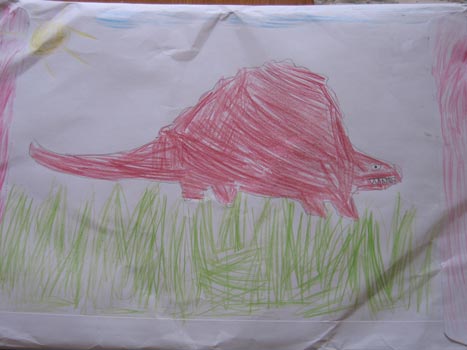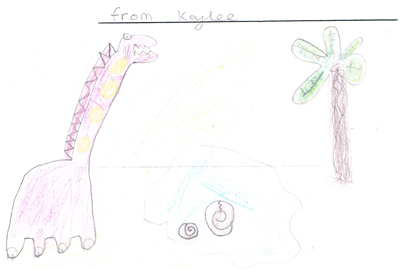Class 2T Learn About Fossils and Dinosaurs
Year 2 Pupils at Morecambe Primary School Study Dinosaurs
After a morning of dinosaur workshops working with children studying Key Stage 1, Everything Dinosaur set the pupils a challenge. We had done our best to answer their questions as we explored fossils and prehistoric animals but inevitably there was not enough time to answer some of the questions that the children had prepared. So with Mrs Todd’s and Miss Bolton’s permission (Year 2 teachers), a creative writing exercise was proposed. The children were challenged to write to the Everything Dinosaur offices telling us about their favourite dinosaur or prehistoric animal fact. If they had a question, then this too could be sent into us for our dinosaur experts to have a look at.
Answering Questions about Dinosaurs
A few days ago, we received a big pile of letters from the children in class two. There was even a drawing of a fearsome looking monster on the back of the envelope that contained the children’s correspondence.
Colourful Envelope with Prehistoric Animal Drawing
Picture credit: Class Two
Amazing Questions and Drawings
There were certainly a lot of amazing questions contained in the letters and plenty of dinosaur facts as well. Class 2 certainly enjoyed themselves, Billy, Alice B, Jack B, Ellie, Amy, Darcey, Jenny, Nathan, Freya and Zara all declared that they would like to become palaeontologists when they are older. With over 1,200 different types of dinosaur having been discovered, I think we will be glad of their help. The children had illustrated their letters with lots of beautiful drawings of prehistoric animals, we have posted some up onto our warehouse wall.
Zara Drew an Orange Coloured Dinosaur
Picture credit: Zara (Class Two)
Fossils and Dinosaurs
Whilst at the school, we met a budding scientist called Alexa so we told her and the rest of the class about a dinosaur that had a similar name to hers. We discussed Alxasaurus and on return to the office we emailed over some further information about this particular dinosaur. Gabby was pleased to hear about Alxasaurus and in answer to the question asked, scientists think that this dinosaur would have been about a metre taller than Mrs Cronshaw (teaching assistant).
Jasmine’s Letter Featured a Purple Long-Necked Dinosaur
Picture credit: Jasmine (Class Two)
We had lots of prehistoric animal drawings to admire. Adam drew some ammonite shells and asked how old would the oldest T. rex be? This is quite a tricky question, but palaeontologists think that the biggest Tyrannosaurus rex known, the dinosaur whose fossils can be seen in a museum in Chicago (USA), was probably around thirty years old when she died. The biggest tyrannosaurs probably reached lengths of around thirteen to fourteen metres, we hope this answers Alissia’s question. Our thanks to Isaac who informed us that T. rex lived in North America.
Why do Dinosaurs Battle?
The most popular question that we received was why do dinosaurs battle? This question was asked by Hannah, Harry, Jack and Lawson. Dinosaurs fighting can be seen in films and on television, although, like animals today, for much of the time, most dinosaurs kept themselves to themselves. The carnivores would have hunted and attacked herbivores, whilst some herbivores like the horned dinosaurs may have fought amongst themselves to settle disputes in the herd.
Some meat-eating dinosaurs would have battled others of their own species in fights over resources such as territories or disputes over rights to claim a carcase of another dinosaur for a meal. In most cases, when dinosaurs of the same species argued, it would have been rare for them to come to blows. Usually, as with animals today most disputes were settled with displays before a fight. Amongst most dinosaurs fighting one of their own species would have been very much a last resort – good question though.
Colourful Prehistoric Animals Drawn by Jack
Picture credit: Jack (Class Two)
Kaylee asked how many bones in a Tyrannosaurus rex? This is another tricky question, as since no complete fossilised skeleton of Tyrannosaurus rex has ever been found, nobody knows for sure. A typical human body contains 206 bones, T. rex probably had more bones than we do, it may not have had as many fingers but it had belly ribs called gastralia which we do not and it had a lot of bones in its long tail, perhaps as many as forty. The bones that it did have in its body were much larger than the equivalent bones found in a human being, after all, Tyrannosaurus rex was much bigger than us.
Kaylee’s Prehistoric Scene in Her Letter to Everything Dinosaur
Picture credit: Kaylee (Class Two)
We also received questions about extinction. Some children wanted to know how big was the space rock that crashed into Earth, scientists estimate that it was around ten kilometres (six miles) in diameter. It was travelling at over thirty kilometres (eighteen miles) a second, that is quick enough to travel from Morecambe in Lancashire to Sydney in Australia in around five minutes. Some of the very last dinosaurs to have lived were Tyrannosaurus rex, Triceratops and Edmontosaurus. Questions about the space rock, its size and which were the last types of dinosaur were asked by Joe, Eve, Lydia and Alice T.W.
A big thank you to all the children for the letters, hopefully we have been able to answer them all. A special thank you to Mrs McGowan, Mrs Cronshaw, Miss Bolton, Mrs Coulthard, Mrs Jackson and Miss Woodcock for their assistance during the dinosaur workshops.
Now it’s time to pop into the warehouse and pin some more pictures up onto the wall.
To learn about Everything Dinosaur’s prehistoric animal themed range of toys and games: Prehistoric Animal/Dinosaur Toys, Gifts and Games.






